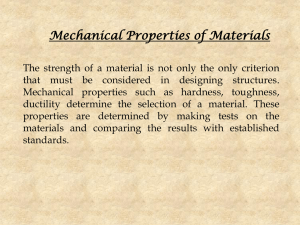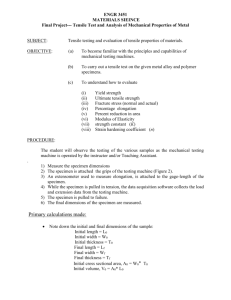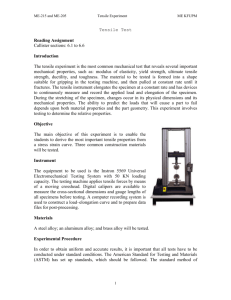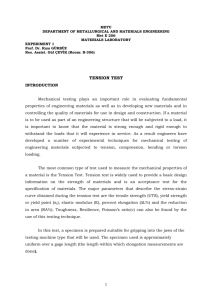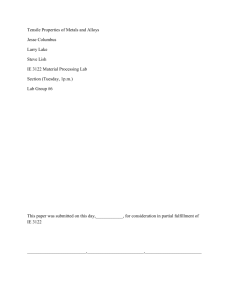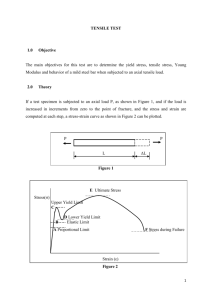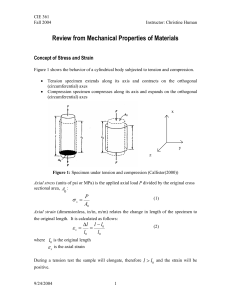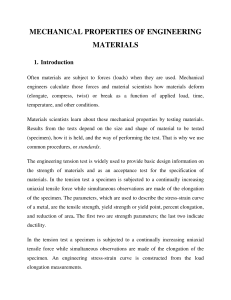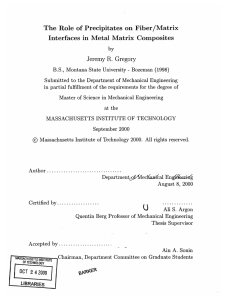lecture notes
advertisement
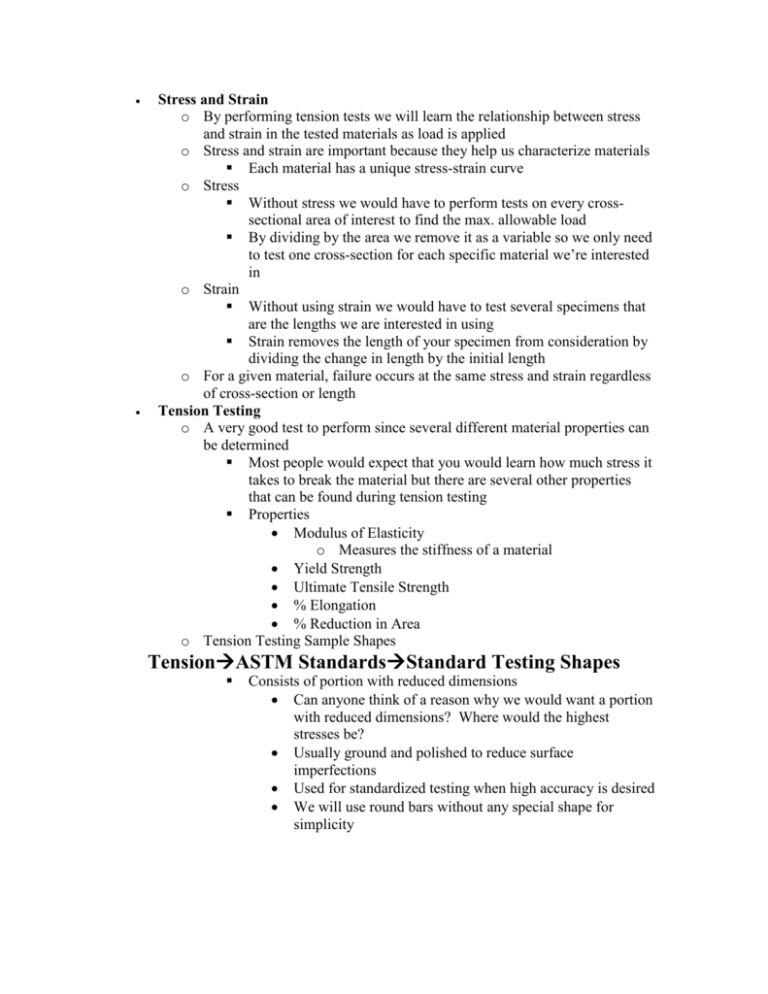
Stress and Strain o By performing tension tests we will learn the relationship between stress and strain in the tested materials as load is applied o Stress and strain are important because they help us characterize materials Each material has a unique stress-strain curve o Stress Without stress we would have to perform tests on every crosssectional area of interest to find the max. allowable load By dividing by the area we remove it as a variable so we only need to test one cross-section for each specific material we’re interested in o Strain Without using strain we would have to test several specimens that are the lengths we are interested in using Strain removes the length of your specimen from consideration by dividing the change in length by the initial length o For a given material, failure occurs at the same stress and strain regardless of cross-section or length Tension Testing o A very good test to perform since several different material properties can be determined Most people would expect that you would learn how much stress it takes to break the material but there are several other properties that can be found during tension testing Properties Modulus of Elasticity o Measures the stiffness of a material Yield Strength Ultimate Tensile Strength % Elongation % Reduction in Area o Tension Testing Sample Shapes TensionASTM StandardsStandard Testing Shapes Consists of portion with reduced dimensions Can anyone think of a reason why we would want a portion with reduced dimensions? Where would the highest stresses be? Usually ground and polished to reduce surface imperfections Used for standardized testing when high accuracy is desired We will use round bars without any special shape for simplicity Lab Procedure o Each group will perform a tension test on two different materials One of the tested materials must be an A36 steel sample Can test either the large or small samples Each group also will select a different material to perform a tension test on o Measure the dimensions of your specimen before testing Need to measure the cross sectional dimensions Also measure the initial length of your specimens Record these on a sheet of paper so when it is your group’s turn you already have the measurements to enter on the computer o Tension Testing Machine TensionAssignmentEquipment and Experimental Procedures We will be using Instron Universal Testing Machines (UTM) The specimens will be loaded in the grips of the machine Be sure to get a full bite on your specimen in the grips A strain-gage extensometer will be connected to record the strain on the specimen Load will then be applied as the machine’s heads will then move apart Load and deflection data will be automatically recorded by the computer Output will be a stress-strain diagram for the test performed Be sure to record the dimensions of the specimen after fracture Measure the same cross-sectional dimensions after fracture Also measure the final length after piecing the specimen back together Stress-Strain Diagrams o Define the following Formulas F F S A Ao S L L f Lo E e e Lo Lo A A L f L0 100% % RA f o 100% % Elong . L0 Ao o Draw the following on the board o Linear Portion of Curve Elastic deformation If load is removed, the material will return to its original shape and size The slope of this portion of the curve is the modulus of elasticity of the material o This is what you found for the sample data sets from the Spreadsheet Lab when you did linear regression o Yield Point The point where the stress-strain relationship stops following a linear curve and becomes nonlinear Point that divides elastic and plastic deformation Plastic deformation is permanent and remains even if the load is removed Some materials have a better defined yield point than others Steel should have a yield point that is easy to find Other materials may not o 0.2% Offset Yield Point Used when there is no clear yield point on the graph Start a line at 0.002 in/in strain and use slope of initial portion of the stress-strain curve Where line intersects the stress-strain curve is the 0.2% offset yield point o Plastic Portion of Curve If load is removed, there will be permanent deformation from the original dimensions Maximum point shows ultimate tensile strength Necking begins at ultimate tensile strength Once necked, less force is required to pull the specimen apart, so the engineering stress decreases True stress continues to increase until fracture o Fracture Final point on the graph is where the specimen has broken into two pieces TensionSpecimen ImagesMacroscopic Fracture Theory Ductile materials Fail due to shear stresses Steel usually has a 45° fracture surface for axial loads May be a cup and cone fracture (steel) Or a straight line fracture (aluminum) Brittle materials Fail due to normal stresses Straight across fracture Not much necking or sign of impending failure o Testing a high temperatures or at high strain rates can change the observed stress-strain curve for a given material Assignment o Formal report worth 100 points Attach your computer print outs Create a table of experimental mechanical properties for both materials tested Modulus of Elasticity Yield strength or 0.2% Offset yield strength Ultimate Tensile Strength Engineering Stress at Fracture True Stress at Fracture % Elongation % Reduction in Area Find reference values only for your A36 steel specimen Compare your A36 experimental values to the reference values using percent error Experiment al Reference 100% o % Error Reference You may not be able to find reference values for all properties o If none, list N/A Discuss reasons why your experimental values may be different from the reference values Compare your second material to steel and show how the two differ Describe one application where the second material would be preferable to steel and one application where the second material would not be as good as steel Also look on Blackboard at ASTM standard E8 and find (3) things that were not performed or that were performed incorrectly when testing the A36 steel specimen Presentation o Each group will come to the board and write your experimental values for the following properties Material Modulus of Yield Strength Ultimate % Elongation Elasticity (ksi) (ksi) Tensile Strength (ksi) o Two questions will then be asked of random groups:
